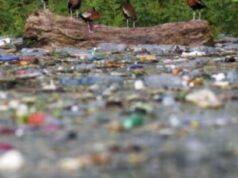The Unsafe Chinese Designed Nuclear Power Plant Under Construction In Pakistan And The Unprepared NDMA Of Pakistan

MONSOON rains come every year and Pakistan is always unprepared, leaving people to struggle with flooded streets and worse. The National Disaster Management Authority and its provincial counterparts clearly keep failing to take proper precautions. What would these bodies do in case of a much worse disaster such as a nuclear accident?
Pakistan’s National Disaster Management Authority has recently released the National Disaster Response Plan 2019. This plan discusses managing monsoons, floods and earthquakes, but is silent on responding to a catastrophic nuclear accident. In the over 100 pages of the new plan, the word ‘nuclear’ appears only once. This is an amazing oversight given that Pakistan has nine operating nuclear reactors (four at Chashma, four at Khushab, and one in Karachi) and two large reactors are under construction in Karachi, and others are planned. Highly feasible potential nuclear accidents are simply wished away.
We know nuclear reactor accidents happen. They can happen due to Chinese design defects, human errors in operations, or due to unexpected natural events like an earthquake or a flood. Large quantities of radioactive materials can escape into the surroundings, making it essential to immediately move populations away from this radioactive contamination. The radiation can pose grave risks to exposed persons for decades.
The accident at Chernobyl in 1986 was caused by a design problem and operator error. An area of 30 Km in every direction was declared an exclusion zone and people were evacuated from there. The contamination of the area was so severe that people are still not allowed back in the exclusion zone after 33 years. Radioactivity from the Chernobyl accident spread as far as Ireland.
Nuclear reactor accidents happen. The radiation can pose grave risks to exposed persons for decades.
The Fukushima accident in 2011 was due to an earthquake-generated tsunami that hit the coast where the reactors were situated and caused multiple meltdowns. People within 30 km of the reactor were evacuated, and only very recently have been allowed back in some places. Most of the radioactivity from the Fukushima accident fortunately blew out to sea. Fear that the wind might change direction led the Japanese prime minister’s office to consider the evacuation of Tokyo, over 200 km away.
The Fukushima disaster could have been much worse. Recent studies have shown the accumulated spent nuclear fuel from many years of reactor operation that was stored in a cooling pool at the site was in danger of overheating and catching fire. The radioactivity contained in this spent nuclear fuel that could have been released was much greater than in the nuclear reactors.
The National Disaster Response Plan 2019 is not alone in its silence on dealing with a severe accident at any of the country’s operating or planned reactors or the stored spent nuclear fuel. The Punjab Disaster Management Authority website mentions the term ‘nuclear disaster’ but offers no measures to handle such a possible event.
The Sindh Disaster Management Authority website has only one ‘nuclear’ item — the ‘Standard Operating Procedure for Kanupp’ (the old reactor operating in Karachi), but this procedure is not available to see. Calling the phone numbers listed on this website leads to a PTCL recorded message “The system does not recognise this number”.
The biggest nuclear risk for any national disaster plan may be the two large nuclear power plants under construction on the Karachi coast. These plants are designed and manufactured by China and have been reported to be beset with problems. They have under the CPEC project. The site is adjacent to the old Kanupp reactor that was built in 1971 when it was believed reactors were safe and should be built close to industrial and commercial centres to save on electricity transmission costs.
The Kanupp site at the time of construction was some 20 km from Karachi’s edge. Since 1971, Karachi has expanded enormously in population and size. It has gone from being a city of two million to about 20m people. Today, some residential areas of Karachi are barely 10 km from the site.
A nuclear reactor core meltdown at one or both of the new Karachi reactors or a spent fuel fire could release radioactivity into the wind. The wind often blows from the nuclear plant site towards Karachi and beyond. Under such wind conditions, the cloud of radioactivity could pass through the entire city, endangering lives of millions and making Karachi uninhabitable for decades.
What would a credible disaster plan for such an accident need to include? First, the National Disaster Management Authority and the one for Sindh must recognise the risk. Then they need to prepare to evacuate people from the areas expected to receive contamination. Any delay could expose people to dangerous levels of radiation.
Evacuation of a city like Karachi is almost unimaginable and certainly cannot succeed if it is not carefully planned and if the people do not cooperate. The biggest challenge would be to take millions of terrified and confused people out of the city through the only three exit roads available: M9, N5 and M10. These roads could be completely clogged.
Where would the Disaster Management Authority relocate these millions of people? Relocation may mean keeping people away from their homes and places of work for years, perhaps decades. They will need food, water, sanitation, medicine, shelter, refuse collection, education, employment, transportation, and so one. Where is the planning for this?
No disaster response plan can work without active support from the at-risk population. People will follow only when they trust the authorities. In Pakistan, there is no such trust in any state authority, with good reason. The National Disaster Management Authority and the one for Sindh must work to earn the public trust.
The National Disaster Management Authority and its partner in Sindh should work with civil society, the city and government agencies to plan and carry out a large-scale rehearsal for how Karachi’s millions of citizens are to be safely and quickly evacuated in the face of a nuclear disaster. Until this can be done successfully, the new Karachi reactors should be not be allowed to operate.
Article has been written by Pakistani physicists.



